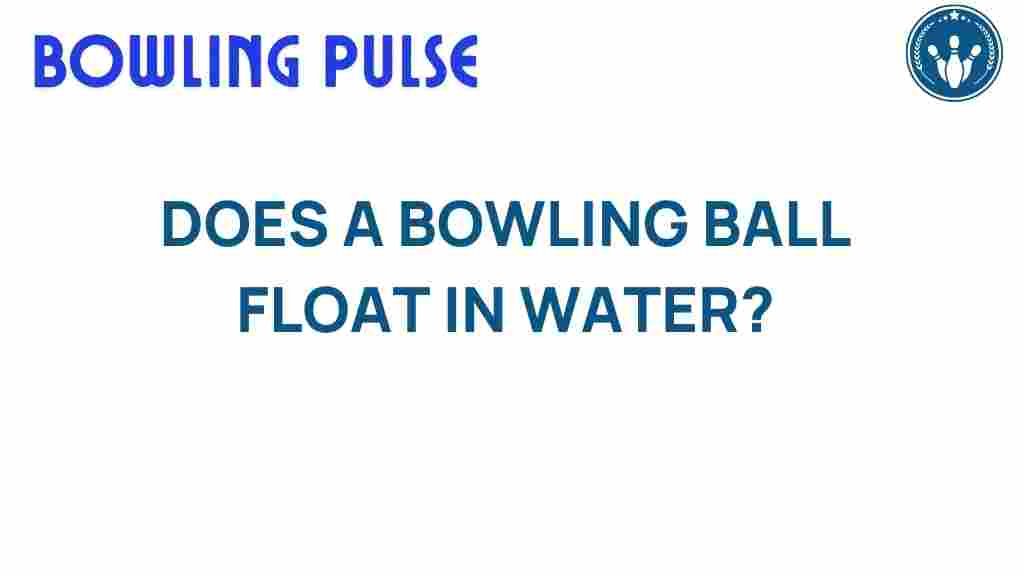The Curious Case of Bowling Balls: Do They Really Float?
When it comes to sports, few things spark curiosity quite like the physics of objects we use every day. One such object is the bowling ball. As we delve into the world of bowling, a fascinating question arises: do bowling balls float in water? This inquiry not only piques our curiosity but also invites us to explore concepts such as density, buoyancy, and sports science. In this article, we will conduct experiments, analyze the science behind the behavior of bowling balls in water, and ultimately answer the question of whether these hefty spheres can actually float.
Understanding Density and Buoyancy
Before we dive into our experiments, it’s essential to understand the key scientific principles at play: density and buoyancy. These concepts will help us frame our exploration of whether a bowling ball can float.
- Density: Density is defined as mass per unit volume. It tells us how much matter is packed into a given space. The formula for density is:
Density = Mass / Volume
- Buoyancy: Buoyancy refers to the ability of an object to float in a fluid. An object will float if its density is less than the density of the fluid it is placed in. This principle is encapsulated in Archimedes’ principle, which states that the upward buoyant force experienced by a body immersed in a fluid is equal to the weight of the fluid that the body displaces.
With these definitions in mind, we can explore the physics behind the bowling ball and its interaction with water.
The Science of Bowling Balls
Bowling balls are typically made from various materials, including plastic, urethane, and reactive resin. Their weight can vary, but most bowling balls weigh between 6 and 16 pounds (approximately 2.7 to 7.3 kg). Understanding the average density of a bowling ball is crucial in assessing its ability to float in water.
The density of water is approximately 1 gram per cubic centimeter (g/cm³). For a bowling ball to float, its density must be less than this value. Most bowling balls have a density greater than that of water, which is why many people assume they cannot float.
Experimenting with Bowling Balls and Water
Now that we understand the concepts of density and buoyancy, let’s conduct a simple experiment to investigate the floating capabilities of a bowling ball.
Materials Needed
- A standard bowling ball
- A large container or bathtub filled with water
- A scale to measure the weight of the bowling ball
Step-by-Step Experiment
- Measure the Weight: Use the scale to determine the weight of the bowling ball.
- Calculate the Volume: Measure the dimensions of the bowling ball (diameter) and use the formula for the volume of a sphere:
Volume = (4/3) × π × (radius)³
- Calculate the Density: Divide the weight by the volume to find the density of the bowling ball.
- Place the Bowling Ball in Water: Gently lower the bowling ball into the water and observe.
Observations
What did you notice when you placed the bowling ball in water? Most likely, it sank! This is consistent with our understanding of density. Since the density of the bowling ball is greater than that of water, it will not float. However, repeating this experiment with a lightweight bowling ball made for children could yield different results.
Troubleshooting Tips
If your bowling ball seems to float or if you encounter unexpected results, consider these troubleshooting tips:
- Check the Weight: Ensure you measured the weight accurately. A lighter ball may float.
- Verify Water Density: Make sure the water is at room temperature, as temperature can affect density.
- Inspect the Ball: Look for air pockets or damage that might alter the ball’s density.
Other Factors Influencing Floatation
While density is the primary factor determining whether a bowling ball will float, there are other interesting elements to consider:
- Material Composition: Different materials will have varying densities. A plastic bowling ball may float if it is significantly lighter than others.
- Air Inside the Ball: Some bowling balls may have air pockets, which can decrease their overall density.
- Water Salinity: In saltwater, the density is higher than freshwater. An experiment in saltwater might yield different results.
Curiosity in Sports Science
The exploration of whether a bowling ball can float exemplifies the intersection of curiosity and sports science. It encourages us to ask questions and seek answers through experimentation. Such inquiries can lead to deeper understanding not only of the objects we use in sports but also of the physical laws governing our world.
For those interested in further exploring the principles of physics in sports, check out this comprehensive guide on sports science and physics.
Conclusion
In conclusion, the curious case of bowling balls floating in water highlights fundamental principles of density and buoyancy. Through our experiments, we found that the average bowling ball, due to its density, does not float in water. However, variations in weight, material, and other factors can influence this outcome.
This exploration invites us to remain curious about the science behind everyday objects and encourages us to conduct our own experiments to discover the fascinating world of physics that governs our activities, including sports. So the next time you’re at the bowling alley, ponder the weight of your bowling ball and whether it could ever float!
For more fun experiments and insights into the world of sports science, consider visiting our resource page for additional information and activities!
This article is in the category Techniques and created by BowlingPulse Team
